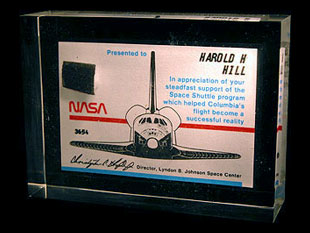|
|

|
Is it legal to privately own
Space Shuttle tiles?
by Joseph Richard Gutheinz, Jr, J.D.
Retired NASA Office of Inspector General (OIG)
Senior Special Agent
It is common to want to hold and possess a piece of space history. With two disasters and many successes, the Space Shuttle has become perhaps the most visible image of NASA's efforts.
Tiles, as the visible protective skin of the Space Shuttle, have been a source of fascination for space collectors; now perhaps more so because of the early suspicions of tile damage and the loss of Columbia.
Shuttle tiles are heavily controlled, for a variety of reasons including their composition, silica, which NASA considers dangerous. According to Johnson Space Center Exhibits Manager Louis Parker, silica tiles can be dangerous because the side that faces the orbiter is rough and produces a fine glass-based dust which can easily get into your eyes and cause damage.
Further, Parker said ITAR (International Traffic in Arms) regulations prohibit NASA from giving shuttle tiles to foreign governments because they fall under a class of technologies prohibited to foreign transfer.
As NASA controls shuttles tiles from cradle to grave, having them destroyed and buried at the end of their usefulness, those who sell or trade them, according to Parker, are breaking the law. Parker said that NASA, through him, lends out tiles to schools and museums, but that NASA always maintains ownership.
Or does it?

Mr. Parker admitted that there was one time in NASA's history when perhaps thousands of shuttle tile pieces were given away and thus can be legally sold, bought and traded.
In 1981, NASA launched its first shuttle mission, STS-1, which also marked the maiden flight of Columbia. Upon its return, flown tiles were broken into 1/2 by 1/2 by 1/4 inch thick pieces and encased in acrylic bars which Parker said looked liked bars of soap.
These "bars" and certificates signed by then Johnson Space Center Director, Dr. Christopher Kraft, were given to every JSC employee, including Parker. Parker said he subsequently gave his piece of tile away.
Also good news for collectors, several retailers now sell samples of Space Shuttle tiles created for Columbia's maiden flight, but were subsequently discarded during the manufacture phase.
These tiles were discarded in 1978, and recovered lawfully. As the tiles were acquired before restrictions were enacted governing their acquisition and sale, the tiles can now be sold legally.
It is NASA's and the United States position that Space Shuttle tiles need to be protected in part because of the technology they contain and the risk from foreign exploitation. Though I am sure this is a sincerely held belief, the reality is this, when NASA gave away pieces from STS 1, and failed to control discarded shuttle tiles created prior to the launch of STS-1, it effectively gave away its technology.
Now NASA has closed, locked and is guarding the barn door to keep the "cows" in, long after they escaped.
For ten years, Joseph Gutheinz was a Senior Special Agent for NASA's Office of Inspector General (OIG). In 1998, Gutheinz was an Undercover Case Agent for Operation Lunar Eclipse, to seize a moon rock presented to the people of Honduras that was smuggled back into the U.S. for sale. Today, he is a trial attorney who now assists other law offices, individuals, and businesses as an attorney and consultant.
|

© 2023 collectSPACE.com All rights reserved.
Questions? E-mail contact@collectspace.com
|
|

|

|
